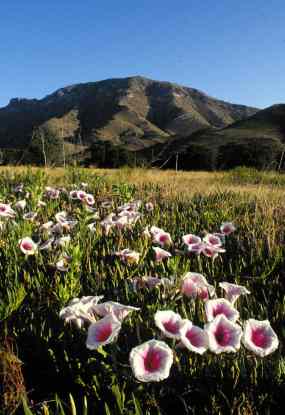 |
 | |
  | |
|
|
|
|
Coronado National Memorial
Nature & Science
|
|
|
|
|
| |
 |
 |
| NPS Photo | | Bob Thompson Peak and morning glory flowers |
 |
When Francisco Vásquez de Coronado came through southeastern Arizona during his quest for Cibola, he was unaware of the riches surrounding him on every side. There were gilded grasslands, flanked by mountains streaked with minerals. They were probably following one of the rarest riches of all in the Southwest – a perennial river. Much later, biological treasures would be discovered in the rocky, wooded memorial set aside to commemorate his epic expedition. Located at the international boundary between the United States and Mexico, the memorial at every turn shows the influences of its neighbor to the south.
Vociferous Mexican jays flock to the picnic area. The Lucifer hummingbird, a distinct Mexican species, makes rare summer appearances at only a few places in the United States, among them Coronado National Memorial. Lucky visitors might spy a tribe of coatimundis, warm-climate relatives of the raccoon and ringtail cat. After the first heavy summer rains, male barking frogs, a tropical species, sing a chorale from the rock outcrops.
|
|  |  |
|
|

Informatión en Español
Flora y Fauna
more... | |
|
|
|
|
|
|
|
 |
|
Did You Know?
At Coronado National Memorial, endangered Lesser Long-nosed bats use natural limestone caves and cave-like mines as their homes for part of the year. Bat-gates, a special type of fencing installed by biologists, prevent humans and predators from disturbing their habitat. Bats can fly right through!
|
|
|
|
Last Updated: June 25, 2007 at 14:24 EST |






